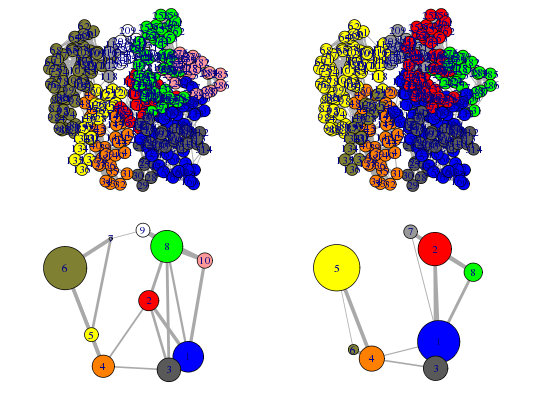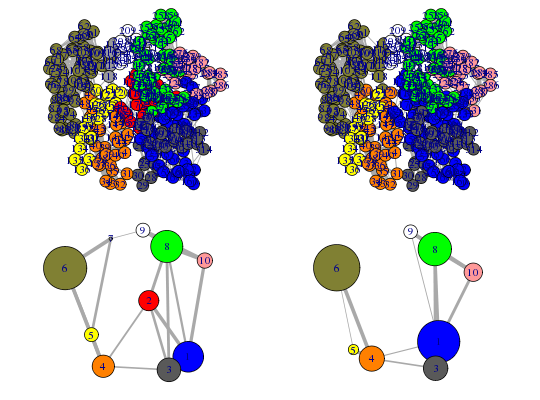Align communities from two or more networks
Usage
community.aln(x, ...)
Arguments
- x, ...
- two or more objects of class
cna(with equal number of nodes) as obtained from functioncna. Alternatively, a list ofcnaobjects can be given tox, the element of which will be used for pairwise comparison.
Value
-
Returns a list of updated
cna objects.
Description
Find equivalent communities from two or more networks and renumber them in a consistent way across networks.
Details
This function facilitates the inspection on the variance of the community
partition in a group of similar networks. The original community numbering
(and so coloring in plot.cna) can be inconsistent across networks,
i.e. equivalent communities may have different numbering in different
networks. The function calculates the dissimilarity between all communities
and clusters communities with ‘hclust’ funciton. In each cluster, 0 or
1 community per network is included. Communities are then renumbered
according to the clusters through all networks. Note that the
‘membership’ in $communities is not updated because some basic
‘igraph’ functions such as length assume the ‘membership’
a consecutive integer vector. Instead, a ‘renumbered’ membership
vector is added as an extra component in the returned ‘cna’ object.
Examples
# Needs MUSCLE installed - testing excluded ## Fetch PDB files and split to chain A only PDB files ids <- c("1tnd_A", "1tag_A") files <- get.pdb(ids, split = TRUE, path = tempdir())|======================================================================| 100%## Sequence Alignement pdbs <- pdbaln(files, outfile = tempfile())Reading PDB files: /tmp/RtmpTDihxb/split_chain/1tnd_A.pdb /tmp/RtmpTDihxb/split_chain/1tag_A.pdb .. Extracting sequences pdb/seq: 1 name: /tmp/RtmpTDihxb/split_chain/1tnd_A.pdb pdb/seq: 2 name: /tmp/RtmpTDihxb/split_chain/1tag_A.pdb## Normal mode analysis on aligned data modes <- nma(pdbs, rm.gaps=TRUE)Details of Scheduled Calculation: ... 2 input structures ... storing 936 eigenvectors for each structure ... dimension of x$U.subspace: ( 942x936x2 ) ... coordinate superposition prior to NM calculation ... aligned eigenvectors (gap containing positions removed) ... estimated memory usage of final 'eNMA' object: 13.5 Mb |======================================================================| 100%## Dynamic Cross Correlation Matrix cijs <- dccm(modes)$all.dccm ## Correlation Network nets <- cna(cijs, cutoff.cij=0.3) ## Align network communities nets.aln <- community.aln(nets) ## plot all-residue and coarse-grained (community) networks pdb <- pdbs2pdb(pdbs, inds=1, rm.gaps=TRUE)[[1]] op <- par(no.readonly=TRUE) # before alignment par(mar=c(0.1, 0.1, 0.1, 0.1), mfrow=c(2,2)) invisible( lapply(nets, function(x) plot(x, layout=layout.cna(x, pdb=pdb, k=3, full=TRUE)[, 1:2], full=TRUE)) ) invisible( lapply(nets, function(x) plot(x, layout=layout.cna(x, pdb=pdb, k=3)[, 1:2])) )
# after alignment par(mar=c(0.1, 0.1, 0.1, 0.1), mfrow=c(2,2)) invisible( lapply(nets.aln, function(x) plot(x, layout=layout.cna(x, pdb=pdb, k=3, full=TRUE)[, 1:2], full=TRUE)) ) invisible( lapply(nets.aln, function(x) plot(x, layout=layout.cna(x, pdb=pdb, k=3)[, 1:2])) )
par(op)

